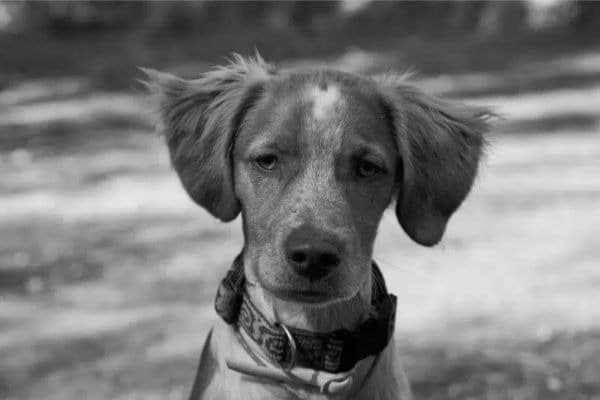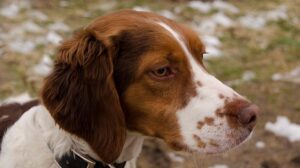
Brittanys & The Pet Peeves of a JEC
Explore the intricacies of judging Brittanys with insights from the Judge’s Education Chair of the American Brittany Club.
Home » Meet The Breeds » Brittany Dog Breed
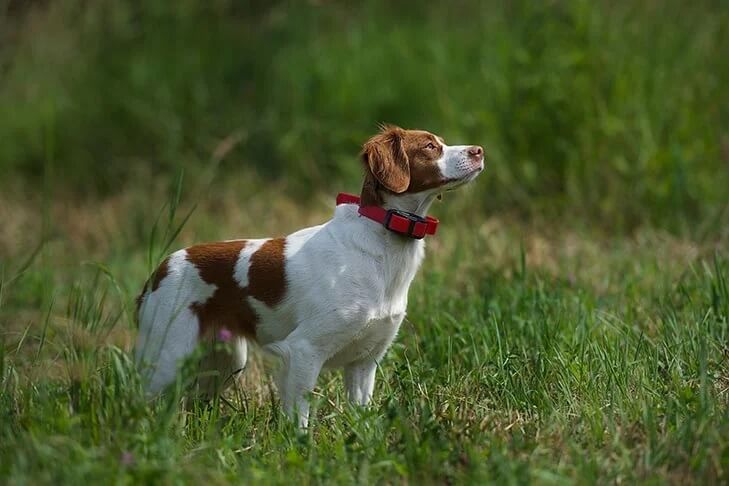


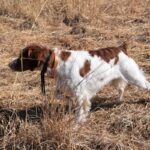


The Brittany, once known as the Brittany Spaniel, is an energetic and versatile bird dog that is renowned for its keen nose and enthusiastic nature. Originating from the Brittany region of France, this medium-sized breed possesses a natural hunting instinct and a love for the outdoors. Its cheerful disposition, combined with a distinctive flat or wavy coat, makes the breed both a treasured hunting companion and a beloved family member.
Sporting
17.5 – 20.5 inches
30 – 40 pounds
12 – 14 years
| Country of Origin | France |
|---|---|
| Bred For | Finding, Pointing & Retrieving Birds, Companionship |
| Known For | Intelligence, Friendliness, Energetic and Quick Movement |
| Popularity | High |
| Temperament | Bright, Fun-Loving, Upbeat |
| Activities | Hunting, Running, Hiking, Conformation Shows, Dog Sports |
The Brittany was known originally as the Brittany Spaniel. Its origins are believed to trace back to the 17th century when they were first utilized as hunters, prized for their ability to point and retrieve game birds.
Hailing from the Brittany region of Northwestern France, a land characterized by rolling hills, dense forests, and a deep-rooted hunting tradition, the Brittany emerged as an indispensable ally for local hunters. The area’s unpredictable terrain required a nimble and energetic dog, and the Brittany, with its agile build and exceptional scenting ability, was an ideal match. This wasn’t simply due to the breed’s physical attributes; the Brittany’s innate sense of companionship and keen intelligence made it an excellent hunting partner.
Renaissance paintings and tapestries offer glimpses of Brittany-like dogs, indicating the breed’s presence and value in high society for centuries. Since French nobility and aristocrats indulged in hunting as a favored pastime, the breed’s reputation grew, transcending its regional confines and noble restrictions.
By the 19th century, the Brittany as a breed began to capture international attention. Its prowess in bird hunting made it a sought-after breed in other European countries and even across the Atlantic. Breeders took note of the Brittany’s rising stardom and commenced dedicated breeding programs, aiming to preserve the breed’s hallmark characteristics.
The early 20th century saw the establishment of formally written Breed Standards. Eventually, a debate eventually arose about the breed’s “spaniel” designation, given that its hunting style is more akin to that of setters and pointers than the flushing spaniels. This culminated in the American Kennel Club dropping “Spaniel” from the breed’s name in 1982, a change that was mirrored by many of the world’s kennel organizations and registries.
Today, the breed stands as a testament to its storied past, seamlessly transitioning from the rugged landscapes of Northwestern France to the manicured lawns of international dog shows. Its evolution from a regional hunting dog to an internationally recognized purebred is a captivating chapter in the annals of canine history.
An adult Brittany typically stands between 17.5 and 20.5 inches tall at the shoulder. In terms of weight, Brittanys generally weigh from 30 to 40 pounds, with individual variations the result of factors such as diet and activity level.
The Brittany boasts a well-proportioned and agile build. When viewed from the side, its body length is approximately the same as its height, giving it a somewhat leggy, balanced, and athletic appearance. The substance of this breed reflects its active nature:. It is solid without being bulky, and its musculature is well-developed.
Texture: The Brittany boasts a coat that’s dense, flat or wavy, being neither silky nor wiry. It offers protection from brambles without being too heavy. It’s also fairly easy to maintain, with a texture that prevents it from tangling easily and only moderate feathering on the legs.
| Standard Color | |
|---|---|
| Liver & White | ee |
| Liver Roan | ee |
| Liver White & Orange | ee |
| Orange & White | ee |
| Orange Roan | ee |
| White & Liver | ee |
| White & Orange | ee |
| Black & White | ee |
| Black White & Orange | ee |
| Blue Roan | ee |
| White Black & Orange | ee |
A Note About Color: A narrow white blaze on the head of the Brittany is desirable. In tri-colored dogs, orange markings appear on the eyebrows, muzzle, cheeks, inside the ears and under the tail, and on any ticking on the legs. Washed-out colors are not preferred.
| Standard Marking | |
|---|---|
| Roan | ee |
| Spotted | ee |
| Ticked | ee |

The Brittany may be born tailless, although its tail is often docked to a length that prevents it from becoming snagged or injured in thick underbrush while hunting. It is set high as an extension of the spine, adding to the breed’s lively expression when in motion or whenever alert. While many Brittanys have their tails docked for various reasons today, undocked tails are not uncommon. The undocked tail is of medium length, carried horizontally or slightly elevated when the dog is in action. Natural or docked, the tail shows a slight feathering.
Brittanys are energetic and versatile companions that thrive both as hunting partners and family members. Their friendly disposition, combined with their active nature, requires a preparedness for the exercise and training requirements of this breed as well as for its healthcare needs.
Brittanys are generally robust and healthy dogs, blessed with a lively and resilient nature. However, like all breeds and mixed breeds, they can be susceptible to specific health conditions. Prospective owners should be aware of these potential issues and work closely with a trusted breeder and veterinarian to ensure their dog maintains optimal health throughout its life.
Lifespan: The average lifespan of a Brittany ranges between 12 and 14 years, but with proper care, regular check-ups, and a balanced diet, many can thrive beyond these years.
The Brittany, despite its overall sturdiness, may be predisposed to certain health concerns, including:
The Brittany is often described as a bright and upbeat dog, brimming with energy and a zest for life. The breed’s alert and keen nature makes it an exceptional hunting companion. But beyond the field, they are affectionate and amiable, making them suitable as loyal and devoted family companions.
For novice dog people, a Brittany can be a delightful addition; however, new owners should be prepared for the breed’s high energy and remarkable intelligence. Without proper channels for the breed’s trademark vigor, a Brittany will likely find ways to entertain itself in ways that are beyond mischievous. Regular training sessions and mental stimulation can mitigate this.
Brittanys are known for their sensitive disposition. They respond best to gentle, positive reinforcement training methods. Harsh or negative corrections can be detrimental to their confidence and trust.
One of the Brittany’s distinguishing traits is its sociability. The breed will generally get along well with other dogs, making these dogs a great choice for multi-pet households. Additionally, their gentle nature and playfulness often make them suitable companions for children. However, interactions between young children and any dog should always be supervised.
Their alertness extends to strangers as well. While Brittanys might be initially wary of unfamiliar faces, they aren’t typically aggressive in any way. Instead, after a brief assessment, a Brittany is likely to greet newcomers warmly.
When considering the Brittany’s overall personality, one is reminded of the breed’s dual nature: spirited and driven in the field, yet tender and loving at home. This balance is what endears them to so many enthusiasts and pet owners alike.
Feeding a Brittany appropriately is crucial to ensure its high energy levels are well-supported while maintaining optimal health. As an active breed, the Brittany’s dietary needs might differ slightly from less energetic breeds.
For Brittany puppies, a balanced, high-quality puppy formula is essential. These formulas cater to their rapid growth phase, ensuring they receive the necessary nutrients for healthy bone, muscle, and cognitive development. Typically, puppies are fed more frequently than adults, often three to four times a day, but this will decrease as they grow.
An adult Brittany generally requires a diet that supports an active lifestyle. This usually means a high-protein, quality dog food that provides the necessary energy for the dog’s daily activities. The exact amount can vary based on activity level, age, and metabolism, but on average, an adult Brittany might consume between 1.5 to 2 cups of dry dog food daily, split into two meals.
When determining how much to feed a Brittany, it’s essential to regularly monitor the dog’s weight and body condition. Adjustments can be made based on activity levels and any changes in weight and condition. Overfeeding or underfeeding can have significant health implications, so maintaining a consistent feeding routine and seeking guidance from a veterinarian can ensure a Brittany stays in peak condition.
Lastly, access to fresh water is imperative. Ensuring the Brittany always has clean water available, especially after exercise, helps to keep this active dog hydrated and healthy.
The Brittany is an intelligent and eager-to-please breed of dog, which, when combined with its boundless energy, makes training both a rewarding and necessary endeavor. The breed’s intelligence means it can pick up commands quickly, but it also implies it may become bored with repetitive tasks. Variety in training exercises can be the key to maintaining the Brittany’s interest.
Generally speaking, Brittanys are relatively easy to train, especially when they begin their lessons while young. Positive reinforcement techniques, such as treats and praise, work exceptionally well with this breed. Their sensitive nature means they may not respond well to harsh corrections; patience and consistency are paramount.
While they may not be notorious barkers, Brittanys can be vocal, especially if they spot something interesting or are left alone for extended periods. Proper training and socialization can mitigate excessive barking, ensuring they only use their voice when necessary.
The Brittany’s intelligence is matched by its curiosity. This curiosity, coupled with the breed’s hunting instincts, may sometimes lead to chasing after smaller animals or wandering off to explore. For this reason, recall training is vital, as is ensuring the dog has a secure area to play in and run.
The breed’s predation drive, which is rooted in its hunting heritage, is something owners should be mindful of. This means the Brittany might be inclined to chase after moving objects, whether it’s a squirrel, a car, or a jogger. Early socialization and consistent training can help to channel this instinct in a more controlled manner.
Balancing the Brittany’s enthusiastic spirit requires consistent and diversified exercise. This breed is not one to be content with just lounging around; its inherent energy, rooted in its hunting origins, demands an outlet.
| Energy Level | High |
|---|---|
| Exercise Requirements | 90 Minute/Day, Daily Walks, Vigorous Running, Regular Exercise, Playing with Another Dog, Mental Stimulation |
Brittanys possess a moderate to high energy level, which means they thrive when engaged in activities that challenge both their minds and bodies. A mere walk around the block won’t suffice; they’ll benefit from longer, brisk walks, hikes, or even jogs along a well-worn path. Their agile nature and speed also make them excellent companions for runners or cyclists, but only when the dog is at least two years old.
While the Brittany’s endurance is commendable, it’s the breed’s intensity that sets it apart. Brittanys don’t just play; they immerse themselves in the activity, be it fetch, Agility training, or even a game of chase with fellow dogs.
Playfulness is a defining trait of the Brittany. These dogs revel in games and enjoy interactive toys that challenge them mentally. This playfulness can be harnessed in structured activities like fetch, hide and seek, and tug-of-war, ensuring they remain stimulated and satiated.
However, despite the breed’s high energy level, it’s essential to ensure a Brittany doesn’t overexert itself. Puppies, in particular, should be allowed to set their own pace, as their bones and joints are still developing.
To sum it up, a Brittany requires an active lifestyle to remain happy and healthy. An exercise regimen doesn’t just cater to the dog’s physical needs; it also ensures its mental well-being, warding off potential behavioral issues stemming from anxiety or boredom.
For the Brittany, grooming is a mix of simple care and regular attention. The breed’s coat, while not excessively long, can become matted if left unchecked, especially given the active nature of the breed and its love for the outdoors.
| Coat Type | Fine, Flat, Wavy |
|---|---|
| Grooming Requirements | Weekly Brushing, Occasional Bathing, Routine Ear Cleaning, Periodic Nail Trimming, Regular Tooth Brushing |
A defining feature of the Brittany’s coat is its dense, flat or texture, which provides protection from thorns and brush during hunts. This texture, while beautiful, can trap dirt and debris, requiring periodic brushing. For most Brittanys, a thorough brushing once or twice a week is sufficient to remove loose hairs, remove dirt, and prevent matting, which will keep the coat looking its best.
While Brittanys are not heavy shedders in comparison to some other breeds, they do undergo seasonal shedding, especially in the spring and fall. During these periods, more frequent brushing can help to manage the loose hair and maintain a cleaner living environment.
Bathing is not a frequent requirement for this breed. Due to the coat’s natural oils, over-bathing can strip the Brittany’s skin of essential moisture. As a rule of thumb, baths are needed only when a Brittany is visibly dirty or has a noticeable doggy odor. Using a mild, dog-specific shampoo can ensure the dog’s skin remains hydrated and the coat is always lustrous.
Other grooming essentials for the Brittany include regular nail trimming, ear cleaning, and dental care. Given the breed’s active nature, nails can become damaged and cause discomfort, making weekly or biweekly trimming necessary. The Brittany’s floppy ears can trap moisture, so checking and cleaning them weekly can prevent infections. Lastly, dental care, either through brushing or dental chews, helps in preventing gum disease and ensures fresh breath.
The Brittany is not just a dog; it’s a delightful companion whose zest for life becomes an integral part of the household. Ensuring an optimal living environment is paramount to the breed’s well-being.
While Brittanys are medium-sized dogs, their dynamism might lead one to believe they need vast open spaces to thrive. That’s not strictly the case. They can adapt to apartment living, provided they get their requisite dose of exercise daily. It’s important to remember that what they lack in size, they make up for in energy. A home with a backyard or close proximity to a park would be ideal, but if that’s not feasible, extended walks and regular play sessions will usually suffice.
Brittanys possess a keen sensitivity to the natural environment, and their double coat provides them with some protection against the elements. They manage relatively well in cold weather, with their dense coat shielding them from the chill; however, it’s vital to ensure they aren’t exposed to extreme cold for extended periods. Conversely, in hot weather, while they might be more resilient than breeds with thicker coats, precautions like providing shade, maintaining hydration, and avoiding peak sun hours are essential for every Brittany.
A Brittany’s connection with its family can be profound. These dogs don’t take kindly to being left alone for long durations. If the household routine involves extended hours away from home, it might be worth considering a doggy daycare or hiring a pet sitter. The breed’s sociable nature also means the Brittany generally does well with other pets, especially if introduced with care.
Lastly, the Brittany’s hunting instincts are ever-present. If the home is near a wooded area or any place with abundant wildlife, be prepared for a Brittany that’s alert and eager, possibly with a penchant for chasing. A well-fenced yard or a reliable leash is non-negotiable.
Every dog breed is adorable as a puppy, but there’s something uniquely endearing about Brittany puppies. Their boundless energy, playful antics, and innate curiosity make them a joy to be around. However, as with all puppies, the early stages of a Brittany’s life are crucial for establishing a foundation for future behavior, health, and well-being.
When a Brittany puppy enters your home, it’s akin to welcoming a tiny whirlwind. The breed’s vibrant energy is evident, even from a young age. The first thing to consider is the pup’s safety. Puppy-proofing the home is essential, and it’s important to ensure that harmful substances, potential choking hazards, and dangerous items are out of reach. Remember, a Brittany puppy’s curiosity knows no bounds; it will explore every nook and cranny.
Feeding a Brittany puppy requires some degree of precision. Brittany pups have specific nutritional needs that differ from that of adults, so it is advisable to feed high-quality puppy food that caters to medium-sized breeds. Always consult with your veterinarian to determine the correct portion sizes and feeding frequency. A balanced diet early on will pave the way for robust health in the Brittany’s adult years.
Socialization is a significant aspect of raising a well-adjusted Brittany. It’s crucial to introduce a puppy to various environments, sounds, people, and other animals in a controlled manner. Positive experiences during the formative weeks can shape a pup’s temperament and reduce chances of anxiety or aggressive behaviors later in life.
Training should commence early but always with a gentle hand. Brittanys are eager to please, and with consistent guidance, they can learn commands and behaviors swiftly. In this regard, puppy training classes can be a valuable resource for both the dog and its person.
Health checks and vaccinations are of paramount importance. Regular visits to see a veterinarian ensures that the Brittany pup is on the right track in terms of its growth and development. They also provide an opportunity to ask questions and discuss any concerns.
The Brittany, with its heritage deeply rooted in hunting, is naturally athletic and thrives when engaged in stimulating activities. This breed is not one to sit idle; it seeks adventure and purpose. As a result, Brittanys excel in a variety of activities and dog sports.
The opportunities for a Brittany to shine in the world of dog sports are vast. Engaging these dogs in fun activities not only strengthens the human-canine bond but also provides an outlet for the breed’s boundless energy.
The Brittany is recognized by the world’s leading registries and kennel organizations, which categorize the breed into a specific Group based on its unique characteristics. This breed is recognized worldwide under the following Group designations:
| Organization | Group Designation |
|---|---|
| AKC (American Kennel Club) | Sporting |
| UKC (United Kennel Club) | Gun Dog |
| CKC (Canadian Kennel Club) | Sporting Dogs |
| ANKC (Australian National Kennel Council) | Gundogs |
| RKC (The Royal Kennel Club) | Gundog |
| FCI (Fédération Cynologique Internationale) | Group 7 – Pointing Dogs; Section 1 – Continental Pointing |
The ideal Brittany is described by a Breed Standard that is approved by each of the world’s leading registries and kennel organizations. The Breed Standards for this breed may be found in the following links:
| Organization | Breed Standard |
|---|---|
| American Kennel Club | AKC Brittany Breed Standard |
| United Kennel Club | UKC Brittany Breed Standard |
| Canadian Kennel Club | CKC Brittany Breed Standard |
| Australian National Kennel Council | ANKC Brittany Breed Standard |
| The Royal Kennel Club | RKC Brittany Breed Standard |
| Fédération Cynologique Internationale | FCI Brittany Breed Standard |
Breed clubs play an essential role in preserving the legacy, heritage, and written Standards of dog breeds. For the Brittany, these clubs are not just about promoting the breed’s unique characteristics. They are also hubs for enthusiasts to connect, share information, and celebrate their passion for these lively dogs.
In the United States, the American Brittany Club (ABC) is the recognized parent club for the breed. Founded in the 1940s, the ABC has been instrumental in promoting Brittany’s interests in the US. From educational programs and sanctioned events to important health and wellness initiatives, the club offers a myriad of resources for both novice and seasoned Brittany owners.
The Brittany Spaniel Club of Canada represents the breed in Canada. The club is dedicated to the betterment of the breed, emphasizing responsible care and breeding practices, as well as humane training methods.
In the United Kingdom, The Brittany Club of Great Britain champions the cause of the breed. Established in the late 1980s, the BCGB has been pivotal in fostering appreciation for the Brittany in the UK. The club hosts social and field events, puts on Conformation Shows, and offers guidance for those interested in the Brittany as a companion and hunting partner.
Membership or association with these clubs offers admirers of the Brittany a chance to immerse themselves in the breed, ensuring its legacy continues for generations to come.
While many Brittanys find loving homes, there are instances when these spirited dogs end up in less fortunate circumstances. Brittany rescue groups step in during such times, working tirelessly to ensure that each dog gets a second chance at a loving, forever home.
In the United States, the National Brittany Rescue & Adoption Network (NBRAN) is at the forefront of rescue efforts. Comprising a network of volunteers spread across the country, NBRAN is committed to rescuing, rehabilitating, and rehoming Brittanys that have been abandoned, mistreated, or surrendered for whatever reason.
In the United Kingdom, Brittany Rescue & Rehome serves as a pillar of support for the breed. Beyond the organization’s active involvement in rescue and rehoming initiatives, the group provides invaluable assistance after adoption, ensuring that both the Brittany and its new family adjust smoothly and build strong and lasting bonds.
Yes, Brittanys are excellent family dogs, known for their affectionate and playful nature. They bond closely with family members and are particularly gentle with children. While they are energetic and active, their loyalty and sociability make them a cherished addition to many households.
No dog breed is entirely hypoallergenic, and the Brittany is no exception. While they possess a coat that sheds moderately, the breed is not typically recommended for people with severe allergies. However, with regular grooming and care, some allergy sufferers might find living with a Brittany to be manageable.
Yes! The Brittany’s origin as a bird dog in France makes it a top-tier hunting companion. The breed’s keen nose, agility, and trainability are assets in the field, and these dogs excel particularly in flushing and pointing game birds.
Brittanys do shed, but their shedding level is considered moderate when compared to other breeds. Their fine coat will benefit from regular grooming, which not only helps with managing shedding but also keeps the coat healthy. Brushing several times a week can reduce the amount of hair the Brittany leaves around the house.
Yes, many Brittanys are fond of water and are natural swimmers. Their heritage as versatile hunters means they’re adept at water retrievals alongside their fieldwork. Introducing them to water at a young age, and providing positive experiences, can enhance their natural swimming abilities.
Adult Brittanys are compact yet sturdy, typically standing between 17.5 to 20.5 inches at the shoulder. Their size gives them an advantage in maneuverability during hunts in dense terrains. While they’re among the smaller gundog breeds, their agility and endurance are commendable.
The Brittany boasts a relatively long lifespan, averaging around 12 to 14 years. Proper care, encompassing a balanced diet, regular veterinary check-ups, and mental and physical stimulation, can help to ensure the Brittany leads a healthy and fulfilling life. As always, genetics and environment play dual roles, but many Brittanys can thrive for many years with appropriate care.
Brittanys, with their social and energetic nature, don’t fare well when left alone for extended durations. They thrive on companionship and activity, and prolonged isolation can lead to feelings of loneliness or even destructive behaviors. If an owner’s routine necessitates longer absences, it’s essential to ensure the Brittany has engaging toys or a playmate. To keep a Brittany happy and healthy under these circumstances, a dog walker may be a good option as will periodic doggy daycare sessions.

Explore the intricacies of judging Brittanys with insights from the Judge’s Education Chair of the American Brittany Club.
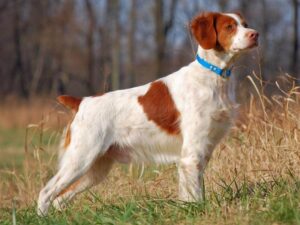
Explore the Brittany Standard for the perfect bird dog characteristics. Learn about size, agility, coat, and more. One breed, one purpose.

Any good dog parent knows that ALL dogs have the potential to help us stay active. That being said, check out this list of energetic dogs.
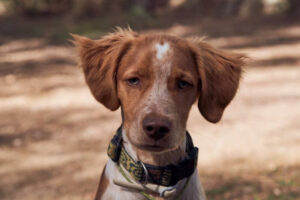
Find out how life with Brittany dogs looks like in this article that covers Brittanys characteristics, traits, personality, behavior & more!
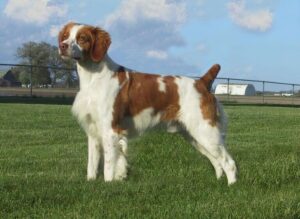
Development of the Brittany Breed Standard, by Jessica Carlson – In 1936, Louis Thebaud and Louis de la Fleche founded the first organization
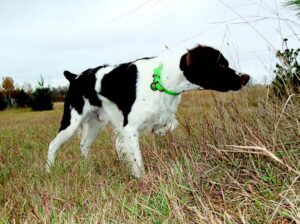
Brittany Judging Simplified | I am the Judge’s Education Coordinator for the American Brittany Club. One of the comments I hear routinely is
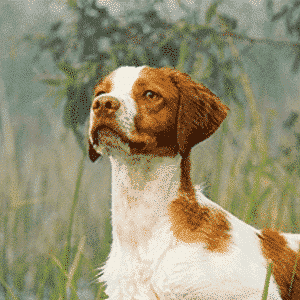
Brittany Heads | Some breeds, where the individual standard places particular emphasis on the head, are frequently called “head breeds.”

Explore the intricacies of judging Brittanys with insights from the Judge’s Education Chair of the American Brittany Club.

Explore the Brittany Standard for the perfect bird dog characteristics. Learn about size, agility, coat, and more. One breed, one purpose.

Any good dog parent knows that ALL dogs have the potential to help us stay active. That being said, check out this list of energetic dogs.

Find out how life with Brittany dogs looks like in this article that covers Brittanys characteristics, traits, personality, behavior & more!

Development of the Brittany Breed Standard, by Jessica Carlson – In 1936, Louis Thebaud and Louis de la Fleche founded the first organization

Brittany Judging Simplified | I am the Judge’s Education Coordinator for the American Brittany Club. One of the comments I hear routinely is

Brittany Heads | Some breeds, where the individual standard places particular emphasis on the head, are frequently called “head breeds.”
The best way to ensure a long and happy relationship with a purebred dog is to purchase one from a responsible breeder. Not sure where to begin?
Contact the National Parent Club’s Breeder Referral Program, which is listed on the AKC Breeder Referral Contacts page.
